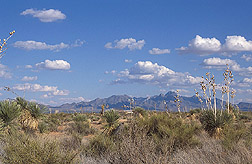This page has been archived and is being provided for reference purposes only. The page is no longer being updated, and therefore, links on the page may be invalid.
|
|
|
|
A Framework for Building New Desert Science
By Don ComisMay 24, 2007
Agricultural Research Service rangeland scientist Jeff Herrick has joined with scientists from around the world to develop a template for a new desertification science that incorporates human as well as biological and physical dimensions.
Herrick is at the ARS Jornada Experimental Range near Las Cruces, N.M. The experimental range includes 193,000 acres of rangeland in the Chihuahuan Desert.
Herrick and colleagues in environmental and social sciences from around the world have written a paper on the subject entitled "Global Desertification: Building a Science for Dryland Development." It was published earlier this month in Science magazine.
The researchers introduced the Drylands Development Paradigm (DDP), named for a 2001 workshop in Berlin, Germany, from which the original framework for solutions to desertification was developed.
Two of the principles of this framework have guided ARS work at the Jornada for many years: that slow variables determine what happens on arid lands, and that these slow variables are often associated with tipping points or thresholds that, if crossed, can rapidly lead to irreversible change.
Experience at the Jornada taught Herrick that arid regions work on "desert time," in which recovery is often initiated by rare events, like unusually large rainstorms. One of the ways this knowledge can be used is by staking seed-filled plastic pipes in dry rills. When rain comes, runoff flows through the pipe, depositing seeds under a layer of litter “mulch” and beginning the slow process of vegetation recovery.
Experience also taught Herrick that natural ecological processes dictate that once a threshold—such as too much weedy brush growth—is reached, it can be very difficult to reverse.
Part of the DDP involves integrating local and scientific knowledge to anticipate thresholds long before they are reached, while they still can be reversed.
It is a framework for actions to support the United Nations' efforts to combat desertification worldwide, recognizing that about 250 million people in the developing world live in arid lands with some form of severe land degradation.
ARS is the U.S. Department of Agriculture's chief scientific research agency.

